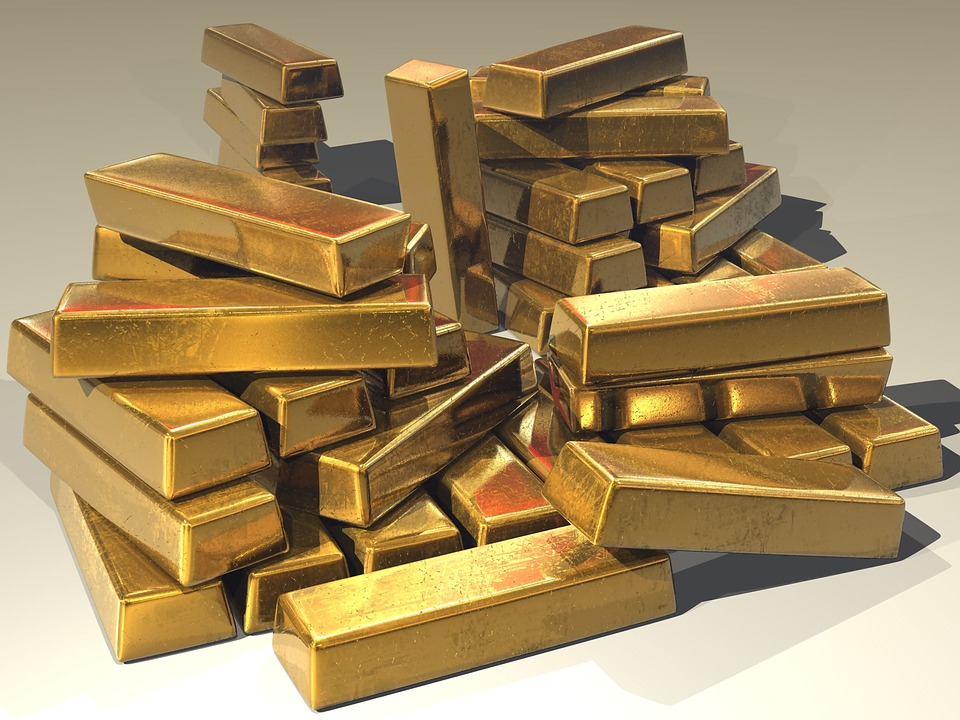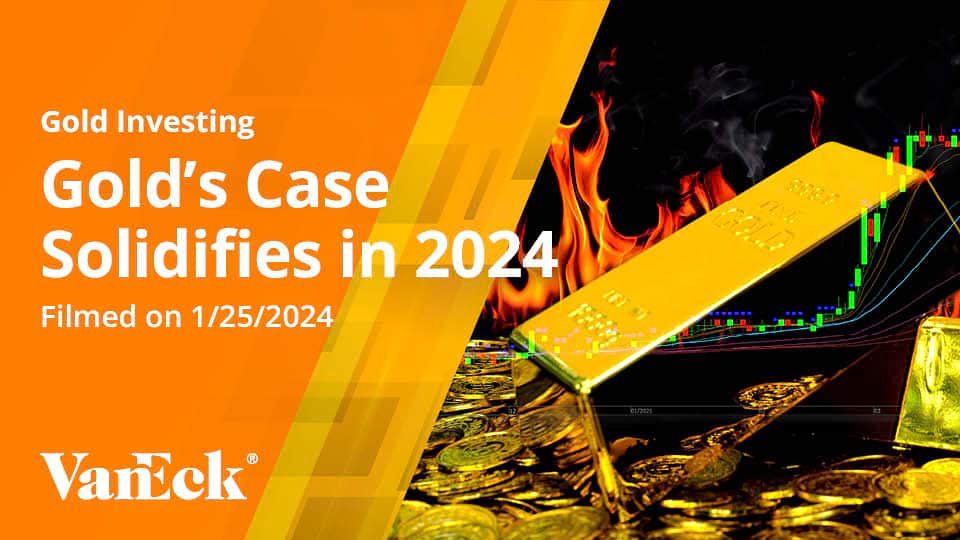Silver’s Golden Outlook
13 February 2024
Read Time 5 MIN
Monthly gold market and economic insights from Imaru Casanova, Portfolio Manager, featuring her unique views on mining and gold’s portfolio benefits.
Gold pauses on rate outlook
Gold traded in a tight range in the first month of 2024, reaching a low of $2,006 per ounce on January 17 as the market reassessed the odds of a U.S. Federal Reserve (Fed) cut in March. The implied probability of the March rate cut dropped from 81.5% at the beginning of the year to 35% at the end of January. Gold found support above $2,000 per ounce even as the U.S. dollar strengthened (DXY index1 was up 1.92%) and yields rose, bouncing back from its lows to close at $2,039.52 per ounce on January 31, down $23.36 or 1.14% for the month.
Miners see further dislocation
Gold stocks had a rough start to the year, once again significantly underperforming the metal. NYSE Arca Gold Miners Index (GDMNTR)2 and MVIS Global Juniors Gold Miners Index (MVGDXJTR)3 were down 9.8% and 10.6%, respectively, in January. The reason behind the amplified losses in gold stocks relative to gold bullion, we believe, was a disappointing set of preliminary 2023 year-end operating results and 2024 guidance for an already-unloved sector. Poor sentiment towards gold stocks has translated into what we generally consider overselling of the companies’ shares following the announcement of any weak or even slightly unexpected results.
Barrick Gold (5.77% of Strategy net assets) is a perfect example. The company announced 2023 fourth quarter and full-year production results that were below market consensus and company guidance. The company also noted that all-in-sustaining costs for 2023, although not reported, would also be higher than expected. The direct impact of these results to the company’s valuation is minimal, but the markets, rightfully so, appeared to have revised their forecasts to reflect a more negative operating outlook. We think this is reasonable, as clearly the negative results for 2023 could indicate weakness in 2024. However, the 9% drop in Barrick’s share price looks overdone to us based on our estimates. In addition, most analysts (Barrick is well covered) kept their targets for Barrick’s shares unchanged after the announcement.
To be clear, we are not making excuses for the companies. As challenging as it may be, companies must make it a priority to inform the markets with annual operating and financial guidance, expectations and targets that they can meet or beat. Misses are severely penalized. However, it really does appear to us that negative sentiment for the gold sector, as a whole, could be intensifying punishment more recently.
Physical demand shines bright
The World Gold Council reported total gold demand in 2023 of 4,899 tonnes, the highest on record and 3% above demand in 2022. Excluding what they refer to as OTC (over the counter) or off-exchange transactions (an estimate that captures the difference between gold supply and demand) 2023 demand was a bit (-5%) below 2022, but still very strong. The changing gold demand dynamics we have been highlighting remain at play: Strong central bank buying as a dominant driver of gold prices in 2023, with demand from the official sector representing over 20% of total gold demand for the year. Net purchases of 1,037 tonnes in 2023 fell just short of the record 1,082 tonnes central banks purchased in 2022, and it is more than double the pre-2022 annual average net purchases of about 500 tonnes of gold per year. This is an impressive trend, expected to continue in the longer-term. In contrast, holdings of global gold bullion ETFs continued to see outflows in 2023, dropping by 244 tonnes, and driving total investment demand to a 10-year low, another reflection of investor’s apathy towards gold as an asset class.*
Annual gold demand by sector
Source: World Gold Council. Data as of December 2023.
Solar silver lining?
A lack of investor interest hasn’t been reserved for gold only. Silver, gold’s less expensive cousin, has been hit even harder, underperforming gold over the last several years. The gold-to-silver ratio (the number of ounces of silver required to buy one ounce of gold) of approximately 90 at present, is well above the 20-year average of approximately 68. Silver, like gold, is a precious metal and, historically, a safe haven asset, driven by the same fundamentals that drive gold. However, silver is also an industrial metal used in a wide range of applications in electronics, medicine, automobiles, appliances, chemical catalysts, and, importantly, silver plays a vital role in the production of solar cells.
The Silver Institute estimates 2023 demand from silver used in photovoltaics (PV) at around 161 million ounces, up from 140 million ounces in 2022, and representing about 13% of total global silver demand.† This demand is, of course, expected to continue to increase to reflect the growth of solar installations as one of the main sources of renewable energy globally. By 2028, International Energy Agency estimates that solar photovoltaics (PV) will account for about 13% of total global electricity capacity, up from approximately 5% of capacity today.‡ The implications for silver are clear, with increasing solar PV demand over the next five years and beyond unlikely to be matched by an increase in supply.
Some rough numbers may help put this in context. A more than doubling of solar PV capacity by 2028 should translate to more than twice the PV demand for silver in 2023, or more than 300 million ounces of silver. Annual global supply of silver has been relatively unchanged over the past 10 years at approximately 1 billion ounces. Thus, this growing demand from solar applications is substantial to an industry that is very inelastic when it comes to the supply side.
Not only are primary silver deposits hard to find, but very few are waiting to be developed, and even when a development decision is made the technical, economic, environmental and social studies, permitting and government regulatory requirements can take as long as a decade or more to complete. Silver, already undervalued relative to gold, could benefit not just from a bounce back to reflect multiples more in line with the historical average, but also from the additional and growing boost from solar.
2023 Performance Gold vs Silver
Source: Bloomberg. Data as of December 2023.
* https://www.gold.org/goldhub/research/gold-demand-trends/gold-demand-trends-full-year-2023.
† https://www.silverinstitute.org/silver-supply-demand/.
‡ https://www.iea.org/reports/renewables-2023/electricity.
1U.S. Dollar Index measures the value of the U.S. dollar relative to a basket of foreign currencies, often referred to as a basket of U.S. trade partners' currencies. 2NYSE Arca Gold Miners Index (GDMNTR) is a modified market capitalization-weighted index comprised of publicly traded companies involved primarily in the mining for gold. 3MVIS Global Junior Gold Miners Index (MVGDXJTR) is a rules-based, modified market capitalization-weighted, float-adjusted index comprised of a global universe of publicly traded small- and medium-capitalization companies that generate at least 50% of their revenues from gold and/or silver mining, hold real property that has the potential to produce at least 50% of the company’s revenue from gold or silver mining when developed, or primarily invest in gold or silver. 4Nasdaq Metals Focus Silver Miners Index is designed to track the performance of companies engaged in the silver mining industry. Eligible companies include those that derive the majority of their revenues from silver mining, have a significant market share of global silver production, or are principally engaged in exploration and development activities related to new silver production.
Related Insights
IMPORTANT DEFINITIONS & DISCLOSURES
This material may only be used outside of the United States.
This is not an offer to buy or sell, or a recommendation of any offer to buy or sell any of the securities mentioned herein. Fund holdings will vary. For a complete list of holdings in VanEck Mutual Funds and VanEck ETFs, please visit our website at www.vaneck.com.
The information presented does not involve the rendering of personalized investment, financial, legal, or tax advice. Certain statements contained herein may constitute projections, forecasts and other forward looking statements, which do not reflect actual results. Information provided by third-party sources are believed to be reliable and have not been independently verified for accuracy or completeness and cannot be guaranteed. Any opinions, projections, forecasts, and forward-looking statements presented herein are valid as of the date of this communication and are subject to change without notice. The information herein represents the opinion of the author(s), but not necessarily those of VanEck.
The views contained herein are not to be taken as advice or a recommendation to buy or sell any investment in any jurisdiction, nor is it a commitment from Van Eck Associates Corporation or its subsidiaries to participate in any transactions in any companies mentioned herein. This content is published in the United States. Investors are subject to securities and tax regulations within their applicable jurisdictions that are not addressed herein.
All investing is subject to risk, including the possible loss of the money you invest. As with any investment strategy, there is no guarantee that investment objectives will be met and investors may lose money. Diversification does not ensure a profit or protect against a loss in a declining market. Past performance is no guarantee of future results.


